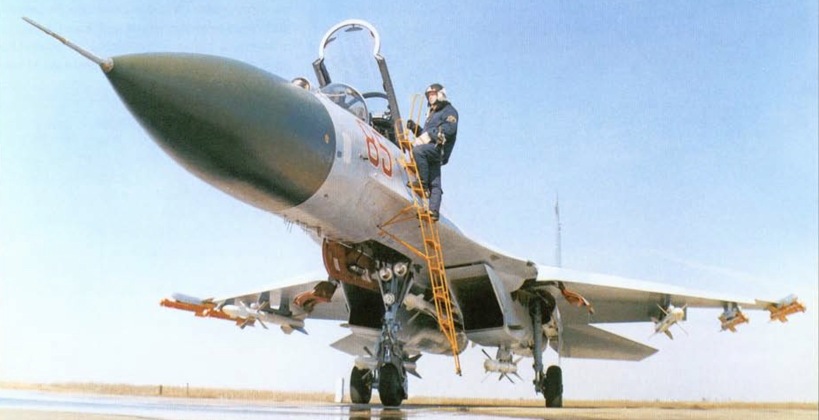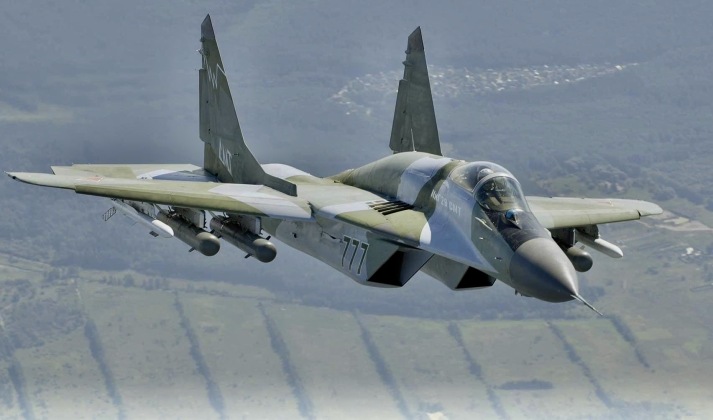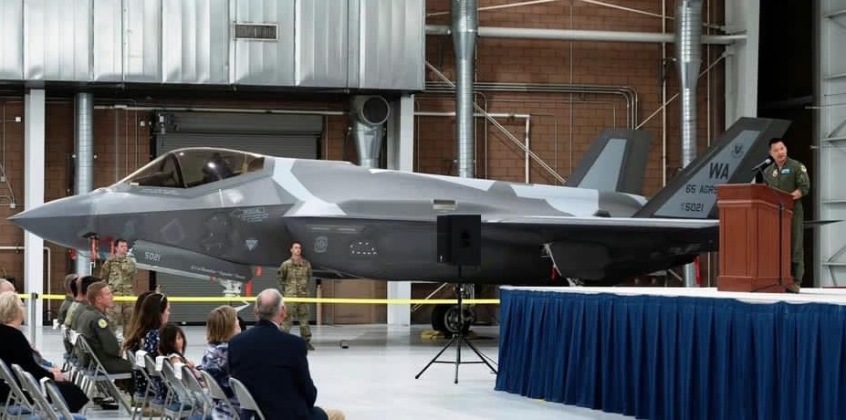News
After Multiple Air-to-Air Kills Over Ukraine Russian Su-35s Are Now Being Used For ‘Aggressor Training’ Simulating NATO Air Attacks
The Russian Air Force has allocated three newly built Su-35S fighter jets to the 185th Combat Training and Combat Application Center of the Aerospace Forces based at Privolzhsky Airbase near the city of Astrakhan – a unit tasked with simulating the capabilities of enemy aircraft in realistic combat training to prepare fighter units to face their most likely possible adversaries. Although widely used in the Soviet era and in the U.S. Military today, the less well funded Russian fleet has had less aggressor training. Such squadrons are valuable as they expose pilots to realistic presentations of enemy equipment, tactics, and operational techniques based on what intelligence on these can be gathered, ensuring aviators are prepared for the kinds of engagements they could encounter in actual combat. Choices of fighters for aggressor training squadrons has traditionally been influenced by what kind of aircraft are fielded by adversaries, with the U.S. Air Force for example allocating F-35s to such squadrons to simulate the capabilities of the Chinese J-20 – since the two are the only production stealth fighters currently in service in meaningful numbers worldwide. China, too, has used its J-20s to simulate the capabilities of American stealth fighters in training. Historically the U.S. Air Force acquired Soviet fighters, and in some cases Chinese derivatives of them, from across the world not only for study but also for aggressor training, which included purchasing Su-27s from Belarus and MiG-29s from Moldova in the 1990s to simulate the capabilities of the jets forming the backbone of the Russian Air Force.  The Soviet Union’s aggressor squadrons fielded MiG-29 fighters before the state’s disintegration, with these aircraft being produced in tremendous numbers providing 800 for service by 1991 and hundreds more for export. The MIG-29 could effectively simulate the capabilities of the American F-15 and F-16 which were the primary challengers to Soviet air superiority, with the MiG being much more manoeuvrable and having a much higher climb rate. MiGs moderating their flight performances could thus provide an equivalent challenge during training. The Soviet Air Force was set to induct Su-27 fighters into aggressor training units in the early 1990s, which could have more accurately simulated the capabilities of the F-15 since both were heavyweights – although the Su-27 was much more manoeuvrable and carried high off boresight visual range missiles and much longer ranged radar guided missiles which the F-15 lacked. With the post-Soviet Russian Air Force’s pilot training programs coming close to collapse in the 1990s as pilots’ average hours in the air fell to around 20 annually, it was only in the 2000s that standards began to improve. Russian fighter pilots nevertheless on average have far fewer hours in the air than their counterparts from China, the U.S., South Korea or other major aerial powers.
The Soviet Union’s aggressor squadrons fielded MiG-29 fighters before the state’s disintegration, with these aircraft being produced in tremendous numbers providing 800 for service by 1991 and hundreds more for export. The MIG-29 could effectively simulate the capabilities of the American F-15 and F-16 which were the primary challengers to Soviet air superiority, with the MiG being much more manoeuvrable and having a much higher climb rate. MiGs moderating their flight performances could thus provide an equivalent challenge during training. The Soviet Air Force was set to induct Su-27 fighters into aggressor training units in the early 1990s, which could have more accurately simulated the capabilities of the F-15 since both were heavyweights – although the Su-27 was much more manoeuvrable and carried high off boresight visual range missiles and much longer ranged radar guided missiles which the F-15 lacked. With the post-Soviet Russian Air Force’s pilot training programs coming close to collapse in the 1990s as pilots’ average hours in the air fell to around 20 annually, it was only in the 2000s that standards began to improve. Russian fighter pilots nevertheless on average have far fewer hours in the air than their counterparts from China, the U.S., South Korea or other major aerial powers.  Until the delivery of the Su-35s the sole Russian adversary training squadron relied on MiG-29s, albeit modernised MiG-29SMT variants with phased array radars and 21st century avionics and weapons allowing them to effectively replicate the capabilities of modernised F-16s, F-18s and F-15s that serve today. The MiG-29SMT is a modernisation package for Soviet-built airframes, and has been exported to Syria and with some modification to India as a cheaper alternative to newly built MiG-29M airframes. Although the Russian Air Force has shown little interest in the MiG-29 since 1991 due to its smaller fleet size and preference for the more capable although more costly Su-27/30/35, it acquired the MiG-29SMT after a batch were returned by Algeria – after it was discovered that these were modernised old airframes rather than newly built ones. Algeria instead purchased Su-30MKA fighters, a class with many similarities to the Su-35, and later ordered the MiG-29M in 2019. With preparations for larger MiG-29SMT production for Algeria having already been made, the Russian Air Force acquired a second MiG-29SMT unit which, with the aggressor squadron already filled, briefly saw frontline service.
Until the delivery of the Su-35s the sole Russian adversary training squadron relied on MiG-29s, albeit modernised MiG-29SMT variants with phased array radars and 21st century avionics and weapons allowing them to effectively replicate the capabilities of modernised F-16s, F-18s and F-15s that serve today. The MiG-29SMT is a modernisation package for Soviet-built airframes, and has been exported to Syria and with some modification to India as a cheaper alternative to newly built MiG-29M airframes. Although the Russian Air Force has shown little interest in the MiG-29 since 1991 due to its smaller fleet size and preference for the more capable although more costly Su-27/30/35, it acquired the MiG-29SMT after a batch were returned by Algeria – after it was discovered that these were modernised old airframes rather than newly built ones. Algeria instead purchased Su-30MKA fighters, a class with many similarities to the Su-35, and later ordered the MiG-29M in 2019. With preparations for larger MiG-29SMT production for Algeria having already been made, the Russian Air Force acquired a second MiG-29SMT unit which, with the aggressor squadron already filled, briefly saw frontline service.  The choice of the Su-35 for aggressor training remains somewhat unusual, as although it is Russia’s most capable air superiority fighter its attributes are entirely different from those of new generations of Western fighters. The only Western heavyweight fighter currently in production, the F-15EX, is being acquired in relatively small numbers and mainly for air defence duties on the U.S. mainland, while the bulk of U.S. and allied acquisitions have focused on the much smaller F-35 stealth fighter. Although the Russian Military has operated alongside fifth generation fighters in the past during exercises with China, where J-20s ‘kicked down the door’ of simulated adversaries serving as a force multiplier for Russian Su-30SM units, the Su-35 as a non stealthy ‘4++ generation’ aircraft is a poor substitute. The fighter’s main combat strengths, its extreme manoeuvrability, triple radars and extreme engagement range, are not currently seen on any Western fighter classes. The possibility remains, however, that the Su-35’s presence at an aggressor training facility could be related to the recent considerable combat experience Su-35 units have reportedly recently gained, with a large number of air to air kills including against MiG-29 and Su-27 fighters of the Ukrainian Air Force attributed to the aircraft which has seen no confirmed losses in air to air combat. The purpose of the Su-35’s presence could well be to impart this experience and thus ensure that lessons learned can benefit more Russian fighter units.
The choice of the Su-35 for aggressor training remains somewhat unusual, as although it is Russia’s most capable air superiority fighter its attributes are entirely different from those of new generations of Western fighters. The only Western heavyweight fighter currently in production, the F-15EX, is being acquired in relatively small numbers and mainly for air defence duties on the U.S. mainland, while the bulk of U.S. and allied acquisitions have focused on the much smaller F-35 stealth fighter. Although the Russian Military has operated alongside fifth generation fighters in the past during exercises with China, where J-20s ‘kicked down the door’ of simulated adversaries serving as a force multiplier for Russian Su-30SM units, the Su-35 as a non stealthy ‘4++ generation’ aircraft is a poor substitute. The fighter’s main combat strengths, its extreme manoeuvrability, triple radars and extreme engagement range, are not currently seen on any Western fighter classes. The possibility remains, however, that the Su-35’s presence at an aggressor training facility could be related to the recent considerable combat experience Su-35 units have reportedly recently gained, with a large number of air to air kills including against MiG-29 and Su-27 fighters of the Ukrainian Air Force attributed to the aircraft which has seen no confirmed losses in air to air combat. The purpose of the Su-35’s presence could well be to impart this experience and thus ensure that lessons learned can benefit more Russian fighter units.












